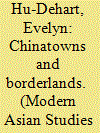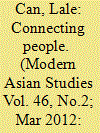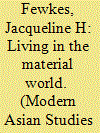|
|
|
Sort Order |
|
|
|
Items / Page
|
|
|
|
|
|
|
| Srl | Item |
| 1 |
ID:
112143


|
|
|
|
|
| Publication |
2012.
|
| Summary/Abstract |
This paper explores two dynamic places and spaces in the Americas, destination of several Asian diasporas-the Chinese, Japanese, and South Asian-as contact and exchange zones. One would be the ethnic enclaves commonly called 'Chinatowns', which stretch over time from the early sixteenth century to the present, and over space from Manila in the Spanish empire across the Pacific to all over the Americas. These Chinatowns, imagined and real and riddled with stereotypes, are well-known tropes on the American landscapes, and need no further preliminary introduction; they are also firmly located within fixed national (or colonial) entities.
The second space has not been historically associated with Asian diasporas in the Americas, although well known for different reasons. Here I refer to 'borderlands', the overlapping space between, over, and above two political national boundaries or borders, in particular the US-Mexican and US-Canadian borderlands, both, coincidentally, clearly marked and delineated by the mid-nineteenth century (1848 and 1846 respectively). Furthermore, as these two transnational/transborder regions are also trans-Pacific, their recognition as an integral part of Asian diasporas is belated and overdue. To make the case further, the study of Asians in the Americas has revealed that Asian migrants, labour, and capital have been historically drawn to these borderlands because they represent dynamic zones of economic development, first in the heyday of maturing American capitalism at the turn of the twentieth century, and again in the glaring eye of current late-capitalist globalization. In other words, Asians have amassed on both sides of these borders for over 100 years, where they have become adept at multiple border crossings, both trans-Pacific and transnational.
|
|
|
|
|
|
|
|
|
|
|
|
|
|
|
|
| 2 |
ID:
112139


|
|
|
|
|
| Publication |
2012.
|
| Summary/Abstract |
Networks of travel and trade have often been viewed as central to understanding interactions among Muslims across South and Southeast Asia. In this paper I suggest that we consider language and literature as an additional type of network, one that provided a powerful site of contact and exchange facilitated by, and drawing on, citation. I draw on textual sources written in Javanese, Malay, and Tamil between the sixteenth and early twentieth centuries to argue that among Muslim communities in South and Southeast Asia, practices of reading, learning, translating, adapting, and transmitting contributed to the shaping of a cosmopolitan sphere that was both closely connected with the broader, universal Muslim community and rooted in local identities. I consider a series of 'citation sites' in an attempt to explore one among many modes of inter-Asian connections, highlighting how citations, simple or brief as they may often seem, are sites of shared memories, history, and narrative traditions and, in the case of Islamic literature, also sites of a common bond to a cosmopolitan and sanctified Arabic.
|
|
|
|
|
|
|
|
|
|
|
|
|
|
|
|
| 3 |
ID:
112141


|
|
|
|
|
| Publication |
2012.
|
| Summary/Abstract |
The role of Sufi networks in facilitating trans-imperial travel and the concomitant social and political connections associated with the pilgrimage to Mecca is often mentioned in the literature on Ottoman-Central Asian relations, yet very little is known about how these networks operated or the people who patronized them. This paper focuses on the Sultantepe Özbekler Tekkesi, a Naqshbandi lodge in Istanbul that was a primary locus of Ottoman state interactions with Central Asians and a major hub of Central Asian diasporic networks. It departs from an exclusive focus on the experiences of elites, to which much of the conventional historiography on Ottoman-Central Asian relations has confined itself, and examines the butchers and bakers, craftsmen and students who set out on the hajj to Mecca in the late nineteenth and early twentieth centuries. Drawing on sources from the private archive of this lodge, the paper reconstructs the experiences of a diverse range of remarkably mobile actors and explores the myriad ways in which this Ottoman-administered institution facilitated their travel to and from Mecca. Through its focus on the conduits and mediators, the structures and buildings-the actual sites-where connections were forged, the paper sheds light on the role that such state-administered Sufi lodges played in delivering on the paternalistic rhetoric and system of sultanic charity that was an integral part of late Ottoman politics and society.
|
|
|
|
|
|
|
|
|
|
|
|
|
|
|
|
| 4 |
ID:
112144


|
|
|
|
|
| Publication |
2012.
|
| Summary/Abstract |
This paper discusses the political opportunity structures which facilitated the creation of sites of interaction and protest against the Asian Development Bank during the Bank's Annual General Meeting in Chiang Mai, Thailand, in 2000. The factors which facilitated the coming together of Thai social movements and their regional and international counterparts are mainly their shared critique of the neo-liberal paradigm and its adverse effects on their respective countries. The strategies they used to highlight these effects enhanced their sites of engagement and confrontation with the Bank and included dialogue with Bank officials, demonstrations, and the use of the media to highlight their concerns. Importance was also placed on the manner in which they were able to mobilize resources for the anti-Asian Development Bank campaigns and the process by which they framed their issues to gain the sympathy and support of the public. The 1997 Asian financial crisis, which highlighted the shortcomings of the Bank's development paradigm, as well as the ongoing democratization process in Thailand during that period, provided the impetus in fostering the anti-globalization alliances of local and transnational social movements in a common venue.
|
|
|
|
|
|
|
|
|
|
|
|
|
|
|
|
| 5 |
ID:
112142


|
|
|
|
|
| Publication |
2012.
|
| Summary/Abstract |
This paper traces a set of interlinked Asianist networks through the activities of Mahendra Pratap, an Indian revolutionary exile who spent the majority of his life at various key anti-imperialist sites in Asia. Pratap envisioned a unified Asia free from colonial powers, but should be regarded as an anti-imperialist first and a nationalist second-he was convinced that India's independence would materialize naturally as a by-product of a federated Asia. Through forging strategic alliances in places as diverse as Moscow, Kabul, and Tokyo, he sought to achieve his goal of a united 'Pan-Asia'. In his view, Pan-Asia would be the first step towards a world federation, in which all the continents would become provinces in a new world order. His thought was an intricate patchwork of internationalist ideas circulating in the opening decades of the twentieth century, and his travels and political activities are viewed in this context. Pratap's exploration of the relationship between the local, the regional, and the global, from an Asian perspective, was one of many ways in which Asian elites and non-elites challenged the legitimacy of the political order in the interwar years.
|
|
|
|
|
|
|
|
|
|
|
|
|
|
|
|
| 6 |
ID:
112138


|
|
|
|
|
| Publication |
2012.
|
| Summary/Abstract |
Intimate interactions across ethnic and cultural lines were integral to the archive of memory within Eurasian families in colonial Penang. Through histories of their European and Asian ancestors, Eurasian families inherited a sense of travel and geographical mobility, and complex forms of cultural exchange often shaped their everyday lives. Eurasian family histories provide access to the messy, lived interactions which formed their social and domestic worlds, but they also hint at their limits. The idea of 'Eurasian' in colonial Malaya was a contentious one, a site for debate, as it was experienced by different people in different ways. During the interwar period, members of Penang's Eurasian elite attempted to define and discipline the divided Eurasian communities of Malaya, by purifying Eurasian family histories of their unruly diversity. In exploring the Eurasian social world of colonial Penang, this paper aims to delineate the fragility of such processes of interaction and exchange.
|
|
|
|
|
|
|
|
|
|
|
|
|
|
|
|
| 7 |
ID:
112136


|
|
|
|
|
| Publication |
2012.
|
| Summary/Abstract |
The historical trading communities of early twentieth century Ladakh, in northern India, interacted with multiple cultures through both travel and the flow of trade goods. Using a neo-pragmatic philosophical framework, I will argue that this community-largely rural and commonly thought of as isolated-was, in fact, cosmopolitan. The traders' interactions with specific commodities prompted them to traverse cultural boundaries and engage with new ideas. This view of cosmopolitanism suggests that, while particular economic, political or social contexts may be part of the settings in which both individuals and communities are engaged in cosmopolitan processes, contexts do not define the cosmopolitan.
|
|
|
|
|
|
|
|
|
|
|
|
|
|
|
|
| 8 |
ID:
112137


|
|
|
|
|
| Publication |
2012.
|
| Summary/Abstract |
Around 1930, at a time of rising nationalisms in China and India, English-educated Chinese and Indians in the British colony of Singapore debated with great intensity the issue of national identity. They sought to clarify their own position as members of ethnic communities of immigrant origin, while remaining individuals who identified the territory of British Malaya as their home. Readers' letters published in the Malaya Tribune, an English-medium newspaper founded to serve the interests of Anglophone Asians, questioned prevailing assumptions of how to define a nation from the perspectives of territory, political loyalty, race, and language. Lived circumstances in Malaya proved that being Chinese or Indian could encompass a range of political, cultural, and linguistic characteristics, rather than a homogenous identity as promoted by nationalist movements of the time. Through these debates, Chinese and Indians in Malaya found ways to simultaneously reaffirm their ethnic pride as well as their sense of being 'Malayan'.
|
|
|
|
|
|
|
|
|
|
|
|
|
|
|
|
| 9 |
ID:
112140


|
|
|
|
|
| Publication |
2012.
|
| Summary/Abstract |
Keramat is the Malay word for the graves of notable figures which are popular sites of prayer and dot the social and physical landscapes of much of Muslim Southeast Asia and the Indian Ocean region as a whole. The term refers to both people as well as their burial sites. Historically, keramat drew people of different ethnic and religious backgrounds. While the venerated dead also came from a variety of ethnic backgrounds, histories, and faiths, they were usually Muslim and frequently Hadrami (from the Hadramaut region in Yemen). In this paper, I view keramat as a significant site of social and cultural diversity. The study of keramat, and the transoceanic movement of the people and faith to which it is linked, may shed further light on the cultural interaction that has historically characterized the region. At the same time, the permissibility of the veneration of graves constitutes a terrain that has long been contested by Muslim scholars. As a result, the fate of this popular practice may offer insights into the complex process of Islamization in the region which began around 700 years ago. I explore two questions in particular. First, in what ways do keramat embody cultural diversity? Secondly, where do keramat stand in relation to state- and organization-driven Islam?
|
|
|
|
|
|
|
|
|
|
|
|
|
|
|
|
|
|
|
|
|